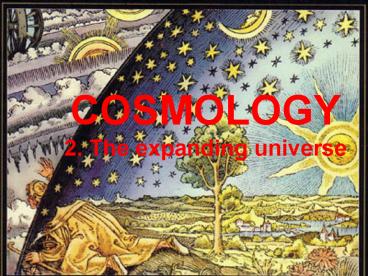COSMOLOGY PowerPoint PPT Presentation
1 / 32
Title: COSMOLOGY
1
COSMOLOGY 2. The expanding universe
2
Hubble Deep Field North
3
Hubble Deep Field South
4
Question Why is the sky dark at
night? (Heinrich Olbers, 1823)
5
(No Transcript)
6
(No Transcript)
7
- Possible answers
- There is an edge to the universe
8
Possible answers There is an edge to the
universe Why does it look
the same in all directions?
9
Possible answers There is an edge to the
universe Why does it look
the same in all directions? Dust obscures the view
10
Possible answers There is an edge to the
universe Why does it look
the same in all directions? Dust obscures the
view Dust would heat up and
radiate IR
11
Possible answers There is an edge to the
universe Why does it look
the same in all directions? Dust obscures the
view Dust would heat up and
radiate IR The universe is young and the speed of
light is finite
12
Possible answers There is an edge to the
universe Why does it look
the same in all directions? Dust obscures the
view Dust would heat up and
radiate IR The universe is young and the speed of
light is finite Yes! The
universe is 13.7 billion years old, and we cannot
see stars whose light takes longer than 13.7
billion years to reach us. This is an ever
expanding horizon.
13
So the universe has a finite age (how do we know
it is 13.7 billion years?) and is therefore not
unchanging with time. (Newton, Einstein and most
people assumed it was infinitely large,
infinitely old, and static.)
14
So the universe has a finite age (how do we know
it is 13.7 billion years?) and is therefore not
unchanging with time. (Newton, Einstein and most
people assumed it was infinitely large,
infinitely old, and static.) In 1929, Hubble
discovered that the universe is expanding
15
Even at the time of the great debate, it was
known that the spectral lines of nearly all the
spiral nebulae were shifted to longer wavelengths
(redshifted). If these are due to the Doppler
effect, then the nebulae are moving away from us.
Nobody knew what to make of this. Hubble set out
to find Cepheids in all of them and determine
their distances. By 1929 he had measured
distances and velocities for 22 nebulae.
16
(No Transcript)
17
Here is the plot from his paper in the
Astrophysical Journal
18
Hubbles velocity measurements were accurate, but
the distances were much too small. (It turns out
there are two types of Cepheid) More modern data
look like
19
And using Type 1a supernovas, we can see one
tenth of the way to the horizon (and the velocity
is one tenth of the speed of light). It is still
a simple linear relationship!
20
We interpret this not as galaxies moving through
space, but as space itself expanding, carrying
the galaxies with it.And as light travels
towards us, its wavelength expands with the
expanding space
21
We interpret this not as galaxies moving through
space, but as space itself expanding, carrying
the galaxies with it.And as light travels
towards us, its wavelength expands with the
expanding space
22
We see all the other galaxies receding from
us. Doesnt that place us at the center of the
universe?
23
NO! An observer on any other galaxy would also
see all the others receding from them, and would
make exactly the same straight line plot of
velocity against distance.
24
So velocity is proportional to distance i.e.
V H x D where H is a constant or
D V / H This gives us a way to estimate the
distance to galaxies that are too far away to see
individual Cepheid stars.
25
The crucial bit is the value of H (called the
Hubble constant and usually written as H0).
Twenty years ago we didnt know it to within a
factor of 2, and this was one of the key projects
for the HST. The modern value is H 22 km/s/Mly
with an error of less than 5. (1 Mly 106
ly) So if you measure a velocity of 2200 km/s,
then the distance is 2200/22 100 Mly If you
measure a velocity of 6600 km/s, then the
distance is 6600/22 300 Mly, and so on.
26
We can rearrange the Hubble law again 1/H D / V
27
We can rearrange the Hubble law again 1/H D /
V But Distance over Velocity is Time.
28
We can rearrange the Hubble law again 1/H D /
V But Distance over Velocity is Time. This is
the time since the galaxies were very close
together and the expansion started.
29
We can rearrange the Hubble law again 1/H D /
V But Distance over Velocity is Time. This is
the time since the galaxies were very close
together and the expansion started. It is the
age of the universe!
30
And its value is Age of the universe 1/H
106 x 1016 meters / 22,000 meters/sec 4.5 x
1017 seconds 14 billion years
31
And in 1967
32
Arno Penzias and Bob Wilson discovered a faint
hiss of radio noise coming uniformly from all
directions. Its spectrum was like thermal
radiation and peaked at a wavelength of 1
mm. Weins Law tells you that the temperature of
this radiation is 3 Kelvins. This is the glow of
the Big Bang!

